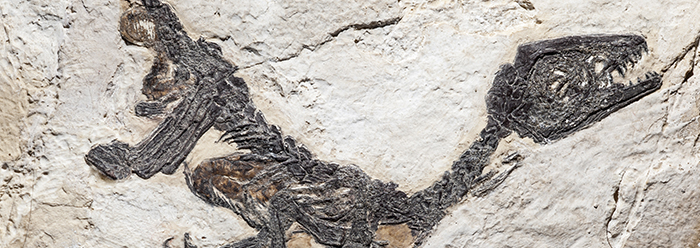Secular geologists hypothesize five major mass extinctions in Earth history and maintain the most catastrophic of these happened nearly 252 million years ago. This Permian extinction, or Great Dying, supposedly resulted in the loss of 70 percent of land species and 95 percent of marine species. What really happened?
Creationists believe the fossil record formed just thousands of years ago as a result of the devastating Genesis Flood. But since those who hold the secular worldview must go to extremes to avoid anything biblical—any explanation but a worldwide flood—these efforts often result in some entertaining extinction stories such as, “A single gene transfer event may have caused the Great Dying.”1
Recently, a paper describes what the authors feel triggered the Permian extinction.2 A science article addressing this states,
As the subsurface magma crystallized into geologic formations called sills, it heated the surrounding carbon-rich sediments and rapidly released into the atmosphere a tremendous volume of carbon dioxide, methane, and other greenhouse gases.3
“This first pulse of sills generated a huge volume of greenhouse gases, and things got really bad, really fast,” says first author and former MIT graduate student Seth Burgess. “Gases warmed the climate, acidified the ocean, and made it very difficult for things on land and in the ocean to survive. And we think the smoking gun is the first pulse of Siberian Traps sills.”3
Fossil record formed just thousands of years ago as a result of the devastating Genesis Flood. ![]()
When viewing a typical fossil graveyard, are we to conclude that we are seeing the results of accumulated greenhouse gases—a period of ancient global warming—or a flood on a worldwide scope that left behind massive sedimentary deposits? Burgess also stated, “Mass extinction can take 10,000 years or less—the blink of an eye, by geological standards.”4 But such a statement does not line up with the fossil record that clearly shows the sudden and catastrophic formation of fossils, a process that kills creatures in their prime and entombs their fresh carcasses in just minutes or less.
This is not the first time assorted volcanic gases were blamed for massive extinction events. In 2012, geologist Gerta Keller suggested volcanic activity associated with the Deccan Traps of India released poisonous levels of carbon dioxide and sulfur causing the K-Pg mass extinction through ocean acidification and, of course, the phrase plucked from today’s headlines: global warming.5
Once again, however, that is not what the fossil record shows. All that is observed is a sudden change in the types of fossils from one sedimentary layer to the next and the preservation of trillions of animals and plants globally. Other evolutionists, such as John Alroy, dispute the “Big Five” extinctions, saying the fossil record shows there have been only three major mass extinctions.6
Volcanism, lava sills & flows, meteoric & tectonic activity, were rife during the Flood year. ![]()
Regardless, evolutionists should be cautious about speculating on events that occurred over a quarter-billion years ago. Jeff Levinton stated,
The estimate of extinction is plagued by other factors as well. Worst of all, the incompleteness of the fossil record imposes biases that cloud an assessment of the tempo and degree of a mass extinction.7
Clearly, volcanism, lava sills and flows, meteoric and tectonic activity, were rife during the Flood year and many decades afterward. There were not five, or three, extinction events during the short history of the Earth, but a single world-wide deluge about 4,700 years ago that altered the very fabric of the Earth’s crust as well as rapidly deposited trillions of fossils in the muddy, entombing Flood waters. So-called extinctions are merely a consequence of the Flood suddenly depositing different animals and plants in subsequent layers as the Flood waters rose higher and higher.
References
- Schultz, C. How a Single Act of Evolution Nearly Wiped Out All Life on Earth. Smithsonian SmartNews. Posted on smithsonian.com April 1, 2014, accessed August 4, 2017.
- Burgess, S., et al. 2017. Initial Pulse of Siberian Traps Sills as the Trigger of the End-Permian Mass Extinction. Nature Communications. 8: 164. doi:10.1038/s41467-017-00083-9
- Chu, J. Initial Pulse of Siberian Traps Sills Triggered End-Permian Extinction. SciTechDaily. Posted on scitechdaily.com August 2, 2017, accessed August 5, 2017.
- Enslin, R. What caused the world’s greatest extinction? ScienceDaily. Posted on sciencedaily.com July 31, 2017, accessed August 23, 2017.
- Keller, G., et al. 2012. Volcanism, impacts and mass extinctions. The Geological Society. Posted on geolsoc.org.uk in 2012, accessed August 12, 2017.
- Alroy, J., et al. 2008. Phanerozoic trends in the global diversity of marine invertebrates. Science. 321 (5885): 97-100.
- Levinton, J. 2001. Genetics, Paleontology and Macroevolution, 2nd edition. Cambridge: Cambridge University Press, 413.
*Mr. Sherwin is Research Associate, Senior Lecturer, and Science Writer at the Institute for Creation Research.
Article posted on September 7, 2017.




















